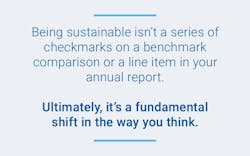Measuring Sustainability: Determine Where You Stand and What to Do Next
It’s relatively easy to follow the building lifecycle as a step-by-step guide for discussing sustainability. In fact, that’s exactly what I’ve done in this Sustainability by Design series.
In my first blog, I introduced sustainability as a broader conceptual framework. Our Sustainability eBook showcased LEED specifications for ensuring a start-to-finish approach to building Planning and Design. In my second blog, we discussed methods of procuring sustainable materials. In the third blog, we spoke to sustainable construction techniques that minimized waste and reduced overall costs.
Here, in blog #4, we’ll review measuring sustainability operations to ensure that you continue to realize the vision and benefits of sustainable facilities practices. When it comes to operations, they key to ongoing success is measurement. However, I’ll also introduce another key factor, and that’s motivation.
Measurement: A Specification and A Comparative Measure
So, you’ve planned it, designed it, acquired sustainable materials and built it using the latest techniques. Now, how do you make sustainability…well, sustainable?
As W. Edwards Deming once stated, “If you can’t measure it, you can’t manage it.” Peter Drucker took that notion one step further with, “If you can’t measure it, you can’t improve it.” So how do you go about measuring sustainability results so you can manage them and know what you need to improve? There are two key factors you need: a specification and a comparative measure.
At 274 pages long, the LEED Green Building Design and Construction Guide can be intimidating and cumbersome to approach. So we created a Beginner’s Handbook to LEED Green Building Design to help you apply sustainable practices to your projects. Download it for free now.
My son runs the mile on his high school track team. The specification in this case is the distance: one mile. The comparative measure is the speed at which other high school runners cover the same distance. If he knows his time (score) for the specification, he can benchmark himself against a peer group to determine how well or poorly he’s doing. It’s great that he can run a five-minute mile, but if every other team has a runner that can do it in four-and-a-half minutes, he’ll never make the podium.
“If you can’t measure it, you can’t improve it.” – Peter Drucker
Fortunately, when it comes to measuring sustainability, there are several specifications that allow you to quantify your results. Then, by comparing your results to other similar entities, you’ll know how well you are managing sustainability and what you may need to improve. Here are two of the best-known specifications:
- LEED: As most know, LEED stands for Leadership in Energy and Environmental Design. LEED provides a comprehensive guidebook for ranking project performance across a number of factors to provide a Platinum, Gold, Silver or Bronze rating. This rating establishes a comparative measure against the LEED Building Design and Construction specification. I used Version 4.1 of this specification as the foundation for our recent Sustainability eBook.
- STARS: Sustainability Tracking, Assessment and Rating System, offers similar ratings but goes a step further by providing an expanded peer group for the comparative assessment. You are not only provided a rating; You are also given insight on how well you are doing against specific competitors and peers. This is of critical importance when you are trying to convince someone where to invest their time and resources. We’ll come back to investment in a bit.
To begin measuring sustainability, you’ll need to establish a baseline for energy consumption and maintenance costs for your facility, so you can measure how well you are operating that physical asset over time. And, if you are going to use sustainability as one of the flagship criteria to promote your organization, entity or institution, you’ll need to know how well you are performing relative to others.
I will note that analyzing a benchmark comparison takes time and resources, and some organizations simply don’t have the time or the resources to commit to that cause. I would be remiss if I didn’t mention that Gordian does offer Sustainability Benchmarking services.
We do all the heavy lifting for measuring sustainability at the facility-level and develop the peer comparison for you. We have done it for over 500 organizations already and we’re always here to help.
Motivation: A Fundamental Shift
The crux of why I am writing this section comes down to your motivation for being sustainable. To take the Deming and Drucker quotes one step further, British psychologist Joan Freeman once wrote, “If you can’t measure it, it doesn’t exist.”
You are welcome to espouse the virtues of your sustainability from the proverbial rooftops of your marketplace until you are blue in the face, but if you are not measuring sustainability performance (and making it part of your culture), does it really exist? Just because you say you are sustainable doesn’t mean that you are. You must measure it in order to prove it. And, if you say you want to be sustainable just to one-up your competition, you are thinking about it the wrong way.
Being sustainable isn’t a series of checkmarks on a benchmark comparison or a line item in your annual report. Ultimately, it’s a fundamental shift in the way you think.
The famous business strategy guru, Gary Hamel is fond of saying, “You can cut one leg off of a fat man, but that won’t make him any thinner.” Meaning, you can do what you want around the periphery of your organization, but, until you change at the core and the culture, you really haven’t embraced the change. Being sustainable isn’t a series of checkmarks on a benchmark comparison or a line item in your annual report. Ultimately, it’s a fundamental shift in the way you think.
In the last blog of this series, I’m going to go deep on ESG: the environmental, social and governance aspects of sustainability. ESG is all about altering your mantra from being sustainable for your shareholders to being sustainable for your stakeholders. That sounds like a subtle leap, but it is a veritable chasm when you cross it.
The C-suite can no longer ignore ESG. Not because it’s the financially prudent approach (minimizing costs and eliminating waste), but because your long-term organizational viability may very well depend on it. The cultural sands are shifting, and you can either ride the wave or be sucked under.
One of the most attractive mutual funds on the market today is comprised entirely of organizations that are fervently embracing the ESG ideals for sustainability, and, as investment pours in, the return is monumental because of their focus on stakeholders and not shareholders. It’s a fascinating market dynamic and I can’t wait to explore it further.
About the Author

John Timmerman
John Timmerman has been in the tech industry since 1990. He has seen the emergence of just about every technology since the advent of the micro-chip. After 28 years in the Smart city and advanced analytics space, John is applying his wealth of understanding to Smart buildings (to include planning, design, construction and facilities management) in his role as Product Marketing Manager at Gordian.

